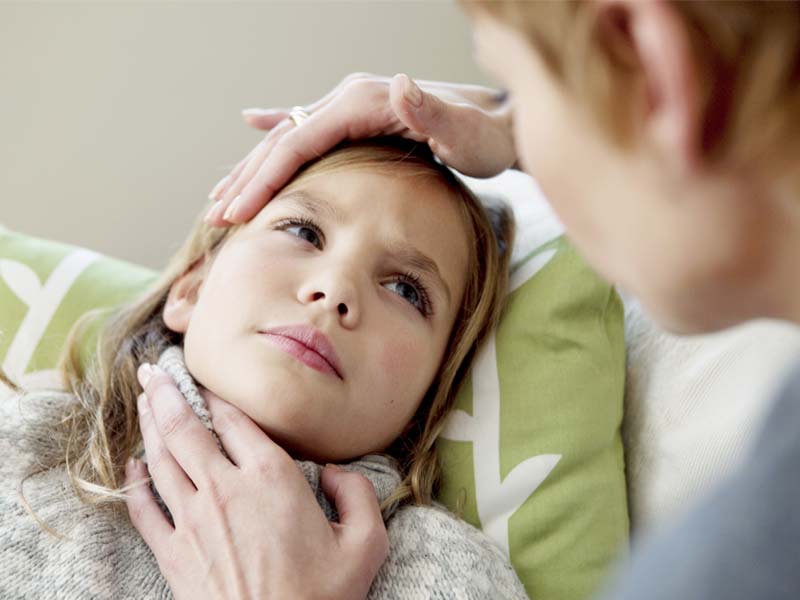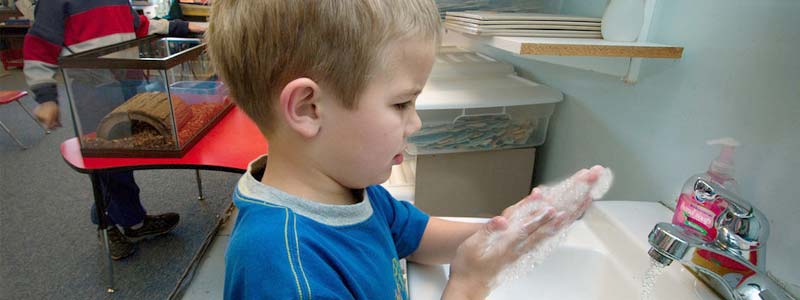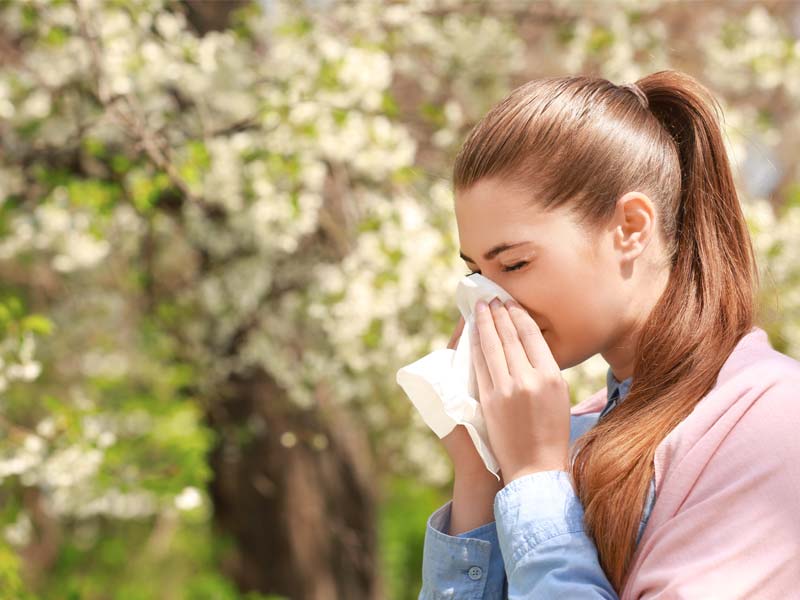
by administrator | May 13, 2019 | Healthy
Seeing your children in sick or in pain is hard. Seeing them sick over and over again with the same thing, and not being able to help, is even worse. For many families, recurring strep throat in a child is an unfortunate reality.
In the past, the only way to prevent chronic strep cases was to remove the child’s tonsils, which comes with its own plethora of dangers. New studies bring to light some answers for the families dealing with this painful illness.
Group A Streptococcus
Strep throat, caused by bacteria called Group A Streptococcus, presents itself as white puss-filled patches on the back of the throat, along with very red and inflamed tonsils. Strep throat is accompanied by a fever and a scratchy, painful sore throat.
What is Recurring Strep Throat
Our clinic sees cases of strep throat every year. When we see the same children over and over, it becomes classified as recurring. Strep is spread through close contact and respiratory particles, so children who attend school or daycare are likely to pick it up easier than those who are not exposed.
New Studies
There have been recent studies that point to a link to genetic variances leaving some kids more susceptible to the bacteria than others. The researchers at the La Jolla Institute for Immunology studied the removed tonsils of 26 children with chronic strep throat, and 39 sets of tonsils from children who didn’t suffer chronic strep, but had them removed for other reasons.
It was found that in children with chronic strep, the tissue genetically had weaker immune responses to the exposure of the bacteria. The tonsils of those children who were not chronic sufferers did not hold those same markers.
While the test base isn’t large enough to make any definitive conclusions, it is a good base to further research. Continuing research could open future doors to vaccines that will help prevent the recurrence of this miserable infection.
Dangers of Strep Throat
Strep throat nearly always comes with a high fever. A fever that is left untreated can cause damage to the heart, brain, and can cause kidney damage. For proper diagnosis and treatment, your child should be seen by their primary care physician. Their doctor can diagnose and prescribe the medications needed to get your child healthy again.
Throughout history, strep and other tonsil related illnesses have resulted in almost automatic tonsil removal. In recent decades, a child would need to see at least seven or eight occurrences of strep in a 12 month period to be considered for a tonsillectomy.
If the tonsils (and often the adenoids) are removed, it may not prevent strep throat and can contribute to future illnesses. The adenoids are the immune glands in the roof of the mouth, and they help your body create the antibodies to fight off infection. They’re often affected by strep throat, but removing them leaves your child vulnerable to other illnesses.
A tonsillectomy requires a hospital visit, anesthesia, and the possibility of complications due to excess bleeding, pain, infection, and more. It really should be a last resort. Furthering studies to create a vaccine for children with the genetic predisposition of this illness would help eliminate the need for this procedure, except in the worst cases.
It’s tempting to avoid the doctor’s visit and treat this illness with home remedies, but in this situation, all you’d be doing is treating the symptoms. While your child is taking their doctor-prescribed medications, you can help them manage their discomfort and try to avoid them spreading it to others.
Natural Symptom Remedies
It’s important to check with your child’s doctor before treating symptoms and pain related to strep throat. Here are a few options you can look into:
- Sleep – Lots of it. Our bodies natural recovery process is to shut down everything that’s non-essential and focus energy on healing. If your child is tired, encourage them to sleep. If they’re too uncomfortable to sleep, resting quietly or watching movies is a great alternative.
- Soft, Smooth Foods – Nothing irritates the throat quite like scratchy or sharp foods. Avoid crunchy things like chips and crackers. Instead, go for soft and smooth foods, like mashed potatoes and jello.
- Hydrate – Drink plenty of water. If your child doesn’t do well with water, try diluted juice, tea, Gatorade, and similar drinks. Less sugar is better, but whatever it takes to get your child to hydrate is good when they’re sick.
- Run a Humidifier – Cool mist humidifiers keep moisture in the air and soothe the soreness in the throat. If you’re an essential oil enthusiast, a diffuser can work for this purpose. Be sure to clear your oil choices with your child’s doctor.

Prevent the Spread of Strep Throat
- Washing your hands, and your child’s hands, is a good start to preventing the spread of any illness, but it’s not enough on its own. Strep is spread through close quarters and respiratory particles like those expelled by coughing.
- Keep antibacterial hand-sanitizer in every room. This will encourage the rest of the family to keep clean and safe, too.
- Cover coughs with disposable tissues; throw them away as soon as you can.
- Wipe all frequently used surfaces with antibacterial wipes.
- If your family is a large one, try to keep sick members isolated from healthy members to the best of your ability.
- Keep sick kids at home. Sending sick kids to school or taking them out in public encourages the spread of germs to those who are immunocompromised.
General cleanliness will help prevent the spread and possibly the recurrence of strep in your home. If it’s not enough, consult with your family doctor to help create an action plan to solve the issue.
Camas Swale Medical Clinic is Here to Help
We’re a partner in your family’s health, and we’re here to help you get and stay healthy. Call us today to schedule a general checkup to maintain your health, or to help you identify and treat injury or illness.

by administrator | Apr 25, 2019 | Healthy
Traveling abroad is one of the most fulfilling and exciting experiences you can have. Traveling can also be something you have to do for work, an event, or a special occasion like a destination wedding. Whether it’s a professional trip or for pleasure, it’s always good to get out of your comfort zone and experience a new place and new people. There are, however, some things to keep in mind. No matter how seasoned a traveler you are, there are many things to do before traveling abroad to ensure that you stay healthy while in a new place.
We’ve highlighted 10 of the most important things you should do before traveling abroad below. Read on to find out how to stay in tip-top condition while exploring the world.
1. Research Your Destination
Are you heading to New Zealand, Thailand, or Israel? Depending on where you’re going, you’ll want to do some research on a few things regarding health. For example, are there vaccinations you need to get before you visit? How is the healthcare system of that country? Should an emergency happen, will you be able to receive the medical attention you need?
We recommend reviewing CDC traveler health advisories, such as malaria endemic regions or other active health threats in the region of interest. See your doctor before travel with questions, or if malaria prophylaxis is recommended.
You never want to go to a new place blindly. Take steps to be as knowledgeable as possible about your options. If you know what city you’re staying in, check to see where the nearest hospital is. Look into what the emergency phone number is for the country. It’s even a good idea to find a drugstore nearby where you’ll be able to get Advil or cough drops. Just 10 minutes of research can go a long way.
2. Get Vaccinated
Make an appointment 3-4 weeks in advance of your trip. Ensure that you’re up to date on all your vaccinations such as tetanus and the yearly flu shot (if it’s the appropriate season). It would be a shame to get something that was preventable on your trip simply because you didn’t take the time to give your doctor a visit. Talk about a bummer!
What about those who know they’re up to date on vaccinations – do they really need to see their doctor? In that case, it depends on the country you’re visiting.
For example, for most western European countries: Canada, Japan, and the US, you probably won’t need any extra vaccinations. However, if you’re going somewhere in the tropics or Africa, you likely will. Malaria, yellow fever, typhoid, and rabies are common travel vaccinations for these countries. This, of course, is not remotely comprehensive, so be sure to do your own research and visit your doctor to get the most accurate information.
3. Refill Your Prescriptions
If you have existing prescriptions, be sure to get any necessary refills ahead of time so that you can pack them with you. No one wants to be caught in a foreign country without their medication. Whether it’s birth control, blood pressure medication, or even prescription allergy pills, be sure to take the time to sort them out thoroughly before you leave.
Don’t forget to review destination laws if you are travelling with prescription medication. Some countries do not allow entry with controlled substances, even with a prescription. Also, make sure all medications are in their original container with prescription attached.

4. Put Good Stuff in Your Body
In other words, eat healthy. It’s always good to eat healthy, but when you physically move your body from one country to another, you encounter all kinds of germs that you may not be prepared for. For example, hundreds of thousands of people go through airports every day, not to mention that many people don’t pay much attention to good hygiene. In a hub of activity that can’t be cleaned as often as necessary, keep that vitamin C flowing through you, just in case.
Bonus Tip: While on your trip, bring supplements to take as you go. You’ll likely be tired from being on the go, and of course, you should rest, but we know how easy it is to get carried away by the exciting new sights and things to do. Putting the right things into your body before and during your trip will help reinforce your body from travel-related maladies.
Some of the best supplements to take, other than Vitamin C, include:
- Activated charcoal tablets (to soak up chemicals that make your tummy unhappy and prevent absorption)
- Probiotics (good bacteria to keep your gut healthy, especially useful when eating spicy or unfamiliar foods)
- Melatonin (to help regulate your sleep, especially if you’re traveling to a place with a significant time difference)
Remember: check with your doctor to make sure these are safe for you to take.
5. Sanitize!
That’s right. Pack a mini hand-sanitizer and reapply, and continue to reapply.
Many countries don’t have soap or sinks in bathrooms, especially if you’re not in a city building. You don’t want to get caught in that kind of a pickle with no way to clean your hands. In less extreme situations, it’s just a good idea to be prepared.
6. Stay Hydrated
This may seem like a no-brainer, but you’d be shocked at how many of us are dehydrated on a regular basis. Before your trip, get into the habit of drinking a lot of water. Carry a water bottle around with you during the day and make a personal water-consumption goal for the day.
When you’re abroad, you’ll likely be walking a lot, especially if you’re a tourist. One of the things that can drain you without you even noticing is not having enough water. We’ve all been in a position where we’re trucking along and all of a sudden we get a headache, need to sit down or get extremely grumpy for no reason. Actually, there is a reason! Your body is telling you to hydrate. If you can get in the habit before you leave, it’ll be easier to remember to drink while you’re out and about abroad.

7. Protect Your Feet in Advance
Wear comfy shoes. Many people ignore this advice, but it’s a must for things to do before traveling abroad.
If you have a pair of shoes you know you’ll want to be walking around in, practice with them before the trip, especially if they’re new shoes. You can buy the best hiking boots on the market but if they’re not broken in, your feet will be very angry with you, and you’ll be mad at yourself, too.
Before your trip, wear your shoes around the house, to the grocery store, on your errands; Everywhere. The whole point is to make sure that when you’re abroad, you won’t be hurting early into the day’s explorations.
8. Sleep
Be sure to regulate your sleep schedule as much as you possibly can before you leave. Get a full 7-8 hours of sleep every night. Starting a trip abroad not refreshed will make the traveling experience much harder the first couple days. Give yourself as much of a boost as you possibly can by starting ready for anything.
9. Create Your Own Travel Kit
You can interpret this as you see fit. Include not only your medications and simple first-aid supplies, but also things you think may make you feel more at home. Traveling light is usually the way to go for most people, but who says you can’t pack a couple of small comforts?
If you have a favorite snack or maybe a favorite token, pack it. A healthy mind often correlates with a healthy body. If you have something that makes you feel comfortable and at home, it’s worth it to bring to put your mind at ease.
10. Relax
Of course, now we say that, but really, traveling isn’t all too daunting if you’re prepared. Get your tasks out of the way early and sit back and relax. Avoid rushing around a day before your flight trying to get everything in order. Do it as early as possible, and you’ll thank yourself.
If you follow these steps, you’ll have a much higher chance of staying healthy and energized on your trip. Preparation almost always pays off, especially in terms of health. If you’re planning a trip, don’t hesitate to reach out to us for vaccinations or additional health recommendations for travel.

by administrator | Mar 27, 2019 | Allergies
With all the snow we’ve had recently, it’s hard to believe it – but spring is finally here. Sunlight and emerging flowers will soon bring a splash of color to your neighborhood, and you will have fewer mornings when you have to leave the house in that thick coat. But for some, spring is spelled A-L-L-E-R-G-I-E-S, which can be a heavy price to pay for all the natural beauty in our state.
If you are one of the many that suffer from these seasonal intruders, you want to do whatever it takes to breathe easier – literally. How can you identify spring allergy symptoms and minimize their effects on your body and overall lifestyle? We’re here to give you some pointers on when it might be time to take action so that you can gain the upper hand on springtime suffering.
Spring Allergy Symptoms Explained
As temperatures rise, a lot of the greenery that has been nurtured by all the rain in our region begins to wake up, releasing its pollen into the air. Pollen can come from not just from flowers, but also from trees and grass.
Your body works hard to protect itself from any intruders and identifies foreign matter like pollen, dander or even mold spores as a threat, which it fights with antibodies. The antibody called Immunoglobulin E (IgE for short) produces histamines that can cause allergic reactions like itchy eyes or a runny nose. Other symptoms can include sinus congestion, post-nasal drip, sneezing, and coughing. For some, an allergic reaction can become severe enough, as in the case of an asthma attack or eyes swelling shut, that their ability to work or even breathe normally is impaired, and immediate medical attention must be sought.
Getting Relief
Allergies are typically at their worst in March through May, but can sometimes start as early as February, as trees can begin to release pollen. Not everyone reacts the same way to allergens or even to the same allergens, so it is a good idea to find out from a doctor which specific ones you react to.
The following are some general guidelines to help you limit your exposure to harmful allergens:
Start Your Spring Cleaning Early
Despite the unpredictability of nature, your home should be a refuge and is one space you can control. You can start by cleaning all the surfaces indoors. Dust your bookcases, clean out light fixtures, vacuum furniture, even wash your curtains and bedspreads. While these may look clean at first glance, they can contain months of pollen buildup from the outdoors.
We mentioned allergic reactions could come not only from pollen that you find outdoors but also from things such as mold. Ensure that moist areas by bathtubs, showers, and sinks (even under sinks) have been thoroughly cleaned. You may want to take the extra step of monitoring humidity levels if you are sensitive to mold, as a humidity level of more than 50% can create an inviting environment for mold to return.
You’ll also want to be aware of allergen-producing plants that are in your yard. If you’re planting or weeding, you can purchase a particulate-filtering mask to protect your lungs. Also, don’t bring what you’re trying to get rid of back inside! Since pollen can stick to your clothing, skin or hair, be sure to clean your clothing and yourself thoroughly when going back indoors.
Keep Your Indoor Air Clean
While you probably aren’t going to live inside a plastic bubble, you can reduce the number of foreign particulates in the air you breathe inside. You can start by keeping the windows shut if you’re suffering from allergies, especially on dry, windy days. The same goes for your car – keep windows up and push your car’s air recirculation button.
If your home has forced air heating or air conditioning, you’ll want to use a high-efficiency HEPA filter. Don’t forget to change it regularly according to its maintenance schedule (usually every three months). Some filters can just be washed instead of replaced. Using a dehumidifier can also keep your indoor air free from unwanted moisture.

Prepare for the Worst
Your local weather report is a great source to find out when pollen levels may be at their highest. During this time, it’s good to keep your doors and windows closed in advance of these events, and avoid outdoor activity in the mornings and early evenings on these days, as that’s when pollen counts are usually the highest.
If you’ve been prescribed allergy medication, it’s best to start taking it in advance of the onset of allergy symptoms. You may start a couple of weeks in advance with over-the-counter medications or even a couple of months, depending on the advice of your doctor, if you’re taking allergy shots.
Over-The-Counter Remedies
Sometimes symptoms are not as severe, and you receive the relief you need through one of many over-the-counter medications. Oral antihistamines, such as Claritin or Zyrtec, can relieve sneezing and itchy eyes. Decongestants like Sudafed or Afrin will give you relief from feeling stuffed up in your nasal passages. Still, other medications, such as Drixoral, combine an antihistamine with a decongestant.
It’s always best to consult with your doctor before treating your allergy symptoms. Some may make you drowsy and should not be used while driving or operating any dangerous equipment. Prolonged use of others can often result in a relapse of symptoms.
Remember – you don’t have to wait until spring allergy symptoms are in full swing to take action. Start preparing now, before they reach their peak levels. Make sure you have cleaned out your home and car, and that you keep the air clean throughout the season. Keep your eyes on the weather and allergen forecasts so you can know when to heighten your defenses.
Also, seek out medical advice in advance as you work to treat any symptoms that may come up. We, at Camas Swale, can equip you with the information you’ll need to ensure a healthier, more comfortable springtime ahead.

by administrator | Mar 13, 2019 | Diet, Healthy, Nutrition
If you stroll through the supplement aisles of your local pharmacy, you are sure to find a large number of omega-3 options on the shelves. Because of all the benefits it provides, you also may have heard about this powerhouse supplement from your doctor. In fact, they may have discussed omega-3 deficiency symptoms with you at your last visit.
In recent years, omega-3 deficiency has come into the limelight. Researchers now encourage medical professionals to consider it when looking at a patient’s symptoms and complaints. Often, the symptoms of an omega-3 deficiency mimic other concerns like low iron or calcium, so the omega-3 problem can slide under the radar. The symptoms can be significant, however, and can impact your health for the worse without you realizing it.
What are Omega-3s, and Why Do They Matter?
Omega-3 refers to a group of three fatty acids that our bodies need that come from animal and vegetable fats. These are the “good fats” you hear about from the doctors and nutritionists. The three types of fatty acids in this group are the following:
- Alpha-linolenic acid (ALA): This acid comes mainly from plant oils, and our bodies cannot manufacture it. We must consume ALA in our food or supplements to get proper amounts. Flaxseed and soybeans are examples of plants that contain ALA.
- Eicosapentaenoic acid (EPA): This acid derives from animal fats and is critical to neurological and cardiovascular health.
- Docosahexaenoic acid (DHA): The longest molecule of the three acids in the omega-3s, DHA comes from animal sources and is also essential to brain and heart health, even in fetal development.
Omega-3 Deficiency Symptoms
When our bodies do not get enough omega-3 fatty acids, deficiencies develop. This situation can lead to significant health problems. Some diets and eating plans can make you prone to this deficiency. For example, diets that are high in red meat and poultry or that significantly restrict fat may lead to fatty acid levels that are too low. While some issues that stem from deficiency may not be apparent to the sufferer, the following more obvious symptoms warrant a check of the patient’s omega-3 levels.
- Problems with skin, hair, and nails. Omega-3s build up cell walls, and when levels are too low, you may experience dry skin, brittle hair, and thin nails that peel and crack. Omega-3 deficiency can cause rashes on the skin and dandruff as well.
- Fatigue and trouble sleeping. It can be very tricky to pinpoint what is causing sleep issues because so many things can contribute to the problem, but a lack of omega-3s is a likely culprit. Boosting your levels can help improve significantly the amount and quality of sleep you get. Once you’re enjoying higher-quality rest, you will see many other health benefits, too.
- Deficits in concentration and attentiveness. Subpar levels of essential fatty acids contribute to difficulty with memory and focus and can lead to irritability and anxiety as well. Children and adults who seem to anger quickly for no reason may actually be suffering from omega-3 deficiency.
- Joint pain and leg cramps. Omega-3s derived from fish oil have excellent anti-inflammatory properties. They naturally reduce swelling and inflammation in the joints and throughout the body. If you do not yet experience joint pain, proper intake of omega-3s can prevent the damage that triggers the pain in the first place.
- Allergy symptoms. Hives, asthma, and eczema can all indicate lowered omega-3 levels.
- Excessive ear wax. This symptom is a strange one, but patients who are tired of the gunk in their ears may find that increasing their omega-3 levels will help alleviate it. Aside from the annoyance of excessive ear wax, the buildup can lead to hearing loss. Consuming enough omega-3s can help protect your hearing. One study showed a 14% reduction in the risk of hearing loss for those who added sufficient fatty acid supplements into their self-care routine.
- Cardiovascular concerns. The research is clear that omega-3s are critical for heart health. If you are experiencing heart problems, it may be that you need to increase your intake of this vital nutrient. It protects against heart disease and helps control your harmful cholesterol levels.
- Difficult menstrual cycles for women. Women who experience prolonged, heavy periods with clotting may get relief by increasing their omega-3 consumption.

How Do I Get Enough Omega-3s?
Given all the health benefits associated with this vital nutrient, it is pretty much a no-brainer that people should be ensuring they consume enough omega-3s. So, how much do you need, and how do you actually get enough of it?
Although over-the-counter supplements are a simple way to increase your omega-3 levels, there are dietary options to boost your levels, too. Whenever possible, it is best to get vitamins and nutrients from our food. Then, when needed, you can add in supplements as well.
There is not a strong consensus in the medical world about how much is an adequate intake of omega-3s, but many experts suggest consuming fatty fish at least twice a week or taking 250-500mg per day to reap the benefits. If you use an omega-3 supplement, be sure it includes EPA and DHA. Specific conditions such as heart disease or depression may warrant higher doses, so be sure to talk with your medical provider about what is best for you.
For food-based fatty acid intake, here are your top choices.
Plant-based sources (provide ALA):
- Flax seeds
- Hemp seeds
- Chia seeds
- Walnuts
- Soybeans
- Spinach
- Brussels sprouts
Animal-based sources (provide EPA and DHA):
- Salmon
- Sardines
- Herring
- Anchovies
- Oysters
- Eggs
Not Sure About Your Levels? Give Us a Call
If you identify with the symptoms discussed here, or if you are wondering if your omega-3 intake is enough, give us a call at Camas Swale today to set an appointment. We’d love to talk with you about food plans and supplement options to make sure you are feeling your best.

by administrator | Feb 21, 2019 | Pain Management
Headaches are one of the most common maladies in the United States. From children to adults, most people experience occasional headaches, but when they become frequent, it can signal a headache disorder that can significantly impact a person’s quality of life. Many Americans suffer not just from headaches, but from migraines specifically.
Understanding how those two conditions differ can be a little tricky. What is the difference between a migraine and a headache? A few characteristics set them apart, but first, let’s look at the basics of what causes headaches in the first place.
What Happens When Your Head Hurts?
Contrary to how it feels, your brain isn’t actually “in pain” when you have a headache. The brain itself has no pain receptors. However, it is the part of the body that receives the pain messages from other areas. When nerves, muscles, and blood vessels around the head and neck tighten or swell, that disruption signals the pain you feel as a headache.
Tension headaches, in particular, indicate a tightness or inflammation somewhere around the brain or in the neck and shoulders. These are the most common type of headaches.
What’s the Difference Between a Migraine and a Headache?
Although it may seem that a headache is just a headache, there are key distinctions that set migraines apart.
Location and Type of Pain
Non-migraines, particularly tension headaches, tend to affect both sides of the head fairly evenly. You likely feel pressure all around the scalp, or in both temples. You may also feel tightness in your neck and shoulders. You may get some pain relief from massaging your neck or temples to relieve the tension.
Although there may be some throbbing pain, a sense of pressure and feeling like something is squeezing your head is more common with regular headaches. Headache pain tends to be mild to moderate for most sufferers.
Migraines, on the other hand, tend to impact one side of the head more severely than the other and usually involve throbbing pain. Migraine headaches typically bring on moderate to severe pain that significantly affects regular daily activities.
Other Symptoms
As annoying and uncomfortable as regular headaches can be, they rarely have other major symptoms with them. Migraine headaches, however, can cause many other issues and problems for the sufferer, such as:
- Nausea – over 70% of migraine sufferers report nausea as a symptom before or during a headache.
- Vomiting
- Sensitivity to light and sound – this is one of the most common migraine headache symptoms.
- Blurred vision
- Pain is worse with movement
- Experiencing an aura – this is a sensation that usually arrives 30-60 minutes before the onset of a migraine. It can include facial tingling or numbness, visual disturbances, or strange smells and sounds.
Triggers and Causes
Tension headaches, as their name implies, arise from tension, pressure, or tightness in the nerves and muscles around the head and neck. This pressure may come from stress, poor posture, injury, or overuse. Sometimes there are trigger points in the neck, shoulders, or back that lead to these headaches.
Non-migraines may also occur with sinus infections, colds, influenza or other illnesses that lead to inflammation. Usually, these headaches subside as the illness runs its course.
Those who suffer from migraine headaches know that many different things can trigger them:
- Monthly cycles and hormone changes – the majority of migraine sufferers are women.
- Food sensitivities
- Bright lights
- Loud noises

When Should You Seek Help?
About 38 million American adults suffer from migraines, but only about half of them seek diagnosis and treatment. If you are experiencing migraine symptoms, it is worth scheduling a visit with your doctor. Aside from pain relief, a provider can make sure there is not a more concerning underlying cause for the headaches and/or migraines with appropriate clinical evaluation. This may involve imaging, special tests, or laboratory blood work, or some combination of these.
If any of these apply to you, it’s time to seek medical help for treatment and symptom control:
- You experience frequent attacks, up to several times per month.
- Your migraines and symptoms control how much you can live your daily life.
- You frequently have to cancel or reschedule activities due to migraines.
- You need pain medication twice a week or more for headache relief.
If you feel like you’re under the control of your migraine headaches and unable to enjoy your daily life on a regular basis, it’s time to let a medical professional help you to get some relief.
Treatment Options
As with most medical challenges, there is no one-size-fits-all solution or treatment plan for migraines and other headaches. The following options have proven successful for many patients:
- For tension headaches: Massage, relaxation, and stress reduction techniques are very beneficial in preventing and stopping tension headaches. In addition, limiting screen time and getting enough sleep are essential to stopping this pain in its tracks. When needed, over-the-counter medications such as acetaminophen and ibuprofen can help alleviate headaches. Another effective treatment option is the use of trigger point injections. Your doctor can talk with you about this form of therapy to see if it is right for you.
- For migraine headaches: In addition to the options above, your doctor can prescribe both preventive medications and drugs that help to stop a migraine once it starts. One of the best techniques to avoid migraines in the first place is to keep a food journal so you can identify any potential food triggers. Many patients can prevent migraine headaches simply by eliminating certain foods. Some patients also find relief through yoga, meditation, and hypnosis. In addition, for migraines that tend to be cyclical and hormonal, addressing any hormonal imbalances can help prevent the onset of migraine headaches.
The team at Camas Swale strives to help you live your best life possible. If headaches and migraines are stopping you from doing that, reach out today to make an appointment.
With a comprehensive list of services, Dr. Armitage provides the care you need at every stage of your life. From family practice to sports physicals to specialized treatment plans, we seek to treat the whole patient with compassion and excellence.
We can’t wait to hear from you and look forward to partnering with you on your health journey. Contact us today.











